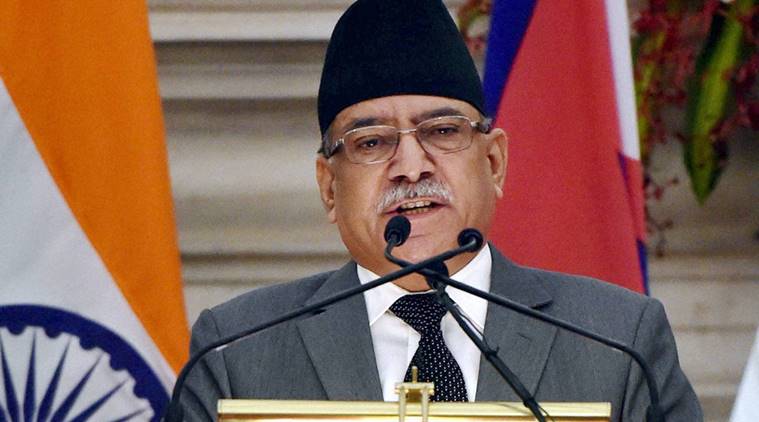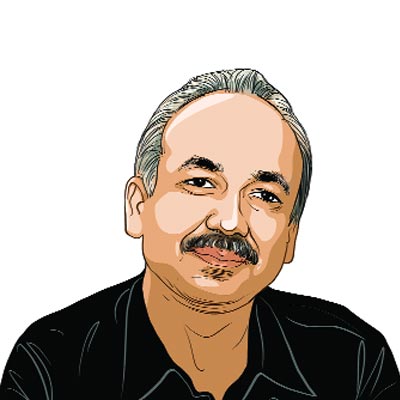Opinion Next door Nepal: Pushpa Kamal Dahal under siege
Dahal, in consultation with the main parties, announced that the local bodies number and boundaries will remain the same as they were 20 years ago when election last took place under the 1991 constitution.
 New Delhi: Prime Minister of Nepal Pushpa Kamal Dahal spekas during a joint statement at Hyderabad house in New Delhi on Friday. PTI Photo by Vijay Verma (PTI9_16_2016_000132A)
New Delhi: Prime Minister of Nepal Pushpa Kamal Dahal spekas during a joint statement at Hyderabad house in New Delhi on Friday. PTI Photo by Vijay Verma (PTI9_16_2016_000132A)  Nepal Prime Minister Pushpa Kamal Dahal File/PTI Photo
Nepal Prime Minister Pushpa Kamal Dahal File/PTI Photo
As the constitution amendment bill over the redrawing of the boundaries of two of the seven proposed federal provinces continues to divide several ethnic groups and major political parties, every attempt by Prime Minister Pushpa Kamal Dahal seeking safe passage is fast turning into a political trap. His calculation that declaring elections to local bodies will be held in mid-April would take political parties to the electoral arena, deflecting their criticism of the government, has fallen apart.
Dahal was even keen at one stage to withdraw the constitution amendment bill to appease the main opposition — the Communist Party of Nepal-Unified Marxist Leninist — if it agreed to support the mid-April polls. But a minority government in a hung parliament has to appease many actors, small or large, with different political perceptions and ideology. That is the predicament Dahal faces as he comes closer to finishing the fifth month of his agreed upon nine-month tenure.
Even before the Balananda committee on restructuring local bodies had submitted its report, protests at the “grass roots” in many parts of the country have become routine, and security forces including the army are apprehensive about violence dominating the scene if the situation continues.
Dahal, in consultation with the main parties, announced that the local bodies number and boundaries will remain the same as they were 20 years ago when election last took place under the 1991 constitution. That constitution was scrapped without due process after king Gyanendra transferred power to political parties in April 2006. But the revival of the same local bodies under a radically different constitution and federal setup means they will not have a balanced proportion to the number and size of the proposed provinces. “By agreeing to hold local bodies elections as envisaged by the 1991constitution, the government appears now reconciled to the fact that the previous constitution was far better,” says Kumar Regmi, a constitutional lawyer. That, in fact, gives a shot in the arm to the group that has been agitating for the revival of the old constitution — which means restoring Nepal’s status as a Hindu kingdom. With the dispute over the boundaries of a few provinces still unsettled, federalism, one of the three main “gains” of the 2006 political change, is nearing a quiet death.
The government has a constitutional obligation to conduct elections to all the three tiers — local bodies, provinces and the federal parliament — by mid-January, 2018. Dahal chose an easier option — he accepted the local bodies’ boundaries in existence during the 1997 elections. This, in a way, is also an admission that conducting elections to the representative bodies at three levels and redrawing new boundaries for local bodies scientifically is not possible within the stipulated time frame. This will also mean an admission of failure of the collective pledge of the ruling coalition — Nepali Congress and the Maoists on one hand, and the main opposition UML — to create an atmosphere for the implementation of the constitution.
CPN-UML still insists on an outright withdrawal of the constitution amendment bill before taking up other issues like holding local bodies elections in April. Nayashakti leader and former prime minister, Baburam Bhattarai, on the other hand, warns that he will lead a movement if local bodies and federal parliament election takes precedence over provincial elections. These threats increase Dahal’s anxieties, although his habit of placating different groups — often offering contradictory assurances — has remarkably reduced his trustworthiness as well.
This political uncertainty has already cast its shadow on parliament, which has remained paralysed for nearly three weeks, mostly thanks to Speaker Onsari Gharti who belongs to the Maoist Party. This is apparently to bail out the PM, who otherwise is sure to face criticism from all sides in the House. An orderly parliament is not in his interest as it will lead to a vote on the constitutional amendment bill and the defeat of the government that could even mean its fall. Nepal is used to frequent changes of government — one almost every nine months — but the change and resultant instability is now being seen as the biggest threat to the constitution.
A constitution that fails to be executed may be written off as “dead” or a failure. But what will guide or govern the country in the absence of a constitution? This will bring the legitimacy of the state institutions, including parliament, into question. Nepal is moving fast towards a constitutional and political vacuum.





